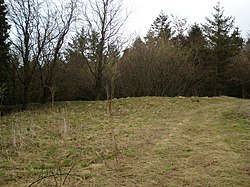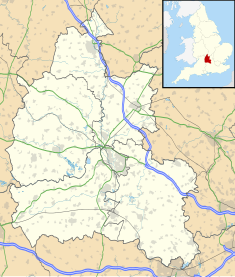| Hardwell Castle | |
|---|---|
| Hardwell Camp | |
 | |
| Type | Hillfort |
| Location | Compton Beauchamp, Oxfordshire |
| Coordinates | 51°34′42″N 1°35′14″W / 51.57844°N 1.58723°W |
| Official name | Hardwell Camp promontory fort |
| Designated | 18 August 1958 |
| Reference no. | 1017820[1] |
Hardwell Castle or Hardwell Camp is an Iron Age valley fort in the civil parish of Compton Beauchamp in Oxfordshire (previously Berkshire).[2]
Site nature[edit]
Like nearby Cherbury Camp, it is not clearly in a strategic or easily defended position. It lies halfway down the scarp slope of the White Horse Hills and is tucked away in a curve, invisible from most angles. This particular positioning suggests its builders had a specialist purpose in mind, although exactly what that may have been remains a mystery. It is also surrounded by a double vallum: its dimensions 140 by 180 ft.[3] It is 'multi-vallate', like Cherbury Camp. It is unexcavated and therefore very little is known about it. The site is described as a promontory fort by Historic England, and has been a Scheduled Monument since 1958.[1]
Location[edit]
The site is at grid reference SU287867 in the Vale of White Horse, very close to the small settlements of both Compton Beauchamp and Knighton, 2 miles from Uffington and 1 mile from the hilltop Uffington Castle.
References[edit]
- ^ a b Historic England. "Hardwell Camp promontory fort (1017820)". National Heritage List for England. Retrieved 13 April 2018.
- ^ "Hardwell Camp [Hardwell Castle] Hillfort". The Megalithic Portal. 11 March 2011. Retrieved 5 November 2018.
- ^ A Handbook for Travellers in Berks, Bucks, and Oxfordshire: Including a Particular Description of the University and City of Oxford and the Descent of the Thames to Maidenhead and Windsor. London: J. Murray. 1872. p. 52.

Well, that’s interesting to know that Psilotum nudum are known as whisk ferns. Psilotum nudum is the commoner species of the two. While the P. flaccidum is a rare species and is found in the tropical islands. Both the species are usually epiphytic in habit and grow upon tree ferns. These species may also be terrestrial and grow in humus or in the crevices of the rocks.
View the detailed Guide of Psilotum nudum: Detailed Study Of Psilotum Nudum (Whisk Fern), Classification, Anatomy, Reproduction